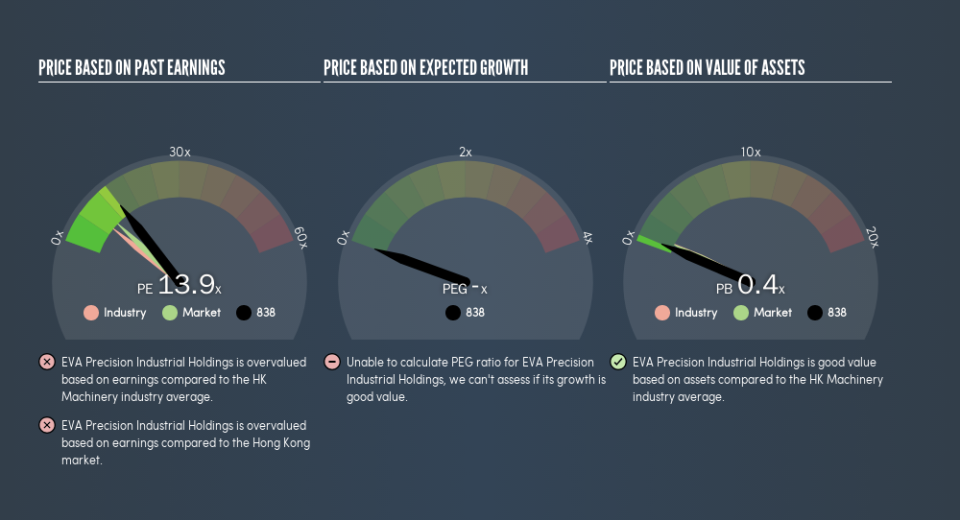Should We Worry About EVA Precision Industrial Holdings Limited's (HKG:838) P/E Ratio?

This article is for investors who would like to improve their understanding of price to earnings ratios (P/E ratios). We'll apply a basic P/E ratio analysis to EVA Precision Industrial Holdings Limited's (HKG:838), to help you decide if the stock is worth further research. EVA Precision Industrial Holdings has a price to earnings ratio of 13.88, based on the last twelve months. That is equivalent to an earnings yield of about 7.2%.
Check out our latest analysis for EVA Precision Industrial Holdings
How Do You Calculate A P/E Ratio?
The formula for P/E is:
Price to Earnings Ratio = Price per Share ÷ Earnings per Share (EPS)
Or for EVA Precision Industrial Holdings:
P/E of 13.88 = HK$0.66 ÷ HK$0.048 (Based on the year to December 2018.)
Is A High Price-to-Earnings Ratio Good?
The higher the P/E ratio, the higher the price tag of a business, relative to its trailing earnings. That isn't a good or a bad thing on its own, but a high P/E means that buyers have a higher opinion of the business's prospects, relative to stocks with a lower P/E.
How Does EVA Precision Industrial Holdings's P/E Ratio Compare To Its Peers?
The P/E ratio indicates whether the market has higher or lower expectations of a company. As you can see below, EVA Precision Industrial Holdings has a higher P/E than the average company (8.1) in the machinery industry.
Its relatively high P/E ratio indicates that EVA Precision Industrial Holdings shareholders think it will perform better than other companies in its industry classification. Shareholders are clearly optimistic, but the future is always uncertain. So investors should delve deeper. I like to check if company insiders have been buying or selling.
How Growth Rates Impact P/E Ratios
If earnings fall then in the future the 'E' will be lower. Therefore, even if you pay a low multiple of earnings now, that multiple will become higher in the future. Then, a higher P/E might scare off shareholders, pushing the share price down.
EVA Precision Industrial Holdings saw earnings per share decrease by 36% last year. But EPS is up 7.6% over the last 5 years. And it has shrunk its earnings per share by 25% per year over the last three years. This could justify a low P/E.
A Limitation: P/E Ratios Ignore Debt and Cash In The Bank
One drawback of using a P/E ratio is that it considers market capitalization, but not the balance sheet. That means it doesn't take debt or cash into account. The exact same company would hypothetically deserve a higher P/E ratio if it had a strong balance sheet, than if it had a weak one with lots of debt, because a cashed up company can spend on growth.
Such spending might be good or bad, overall, but the key point here is that you need to look at debt to understand the P/E ratio in context.
EVA Precision Industrial Holdings's Balance Sheet
Net debt totals 60% of EVA Precision Industrial Holdings's market cap. If you want to compare its P/E ratio to other companies, you should absolutely keep in mind it has significant borrowings.
The Verdict On EVA Precision Industrial Holdings's P/E Ratio
EVA Precision Industrial Holdings trades on a P/E ratio of 13.9, which is above its market average of 10. With significant debt and no EPS growth last year, shareholders are betting on an improvement in earnings from the company.
Investors should be looking to buy stocks that the market is wrong about. If the reality for a company is better than it expects, you can make money by buying and holding for the long term. Although we don't have analyst forecasts, you might want to assess this data-rich visualization of earnings, revenue and cash flow.
You might be able to find a better buy than EVA Precision Industrial Holdings. If you want a selection of possible winners, check out this free list of interesting companies that trade on a P/E below 20 (but have proven they can grow earnings).
We aim to bring you long-term focused research analysis driven by fundamental data. Note that our analysis may not factor in the latest price-sensitive company announcements or qualitative material.
If you spot an error that warrants correction, please contact the editor at editorial-team@simplywallst.com. This article by Simply Wall St is general in nature. It does not constitute a recommendation to buy or sell any stock, and does not take account of your objectives, or your financial situation. Simply Wall St has no position in the stocks mentioned. Thank you for reading.

